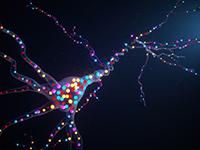Several series of near-infrared (NIR) fluorescent proteins (FPs) were recently engineered from bacterial phytochromes but were not systematically compared in neurons. To fluoresce, NIR FPs utilize an enzymatic derivative of heme, the linear tetrapyrrole biliverdin, as a chromophore whose level in neurons is poorly studied. Here, we evaluated NIR FPs of the iRFP protein family, which were reported to be the brightest in non-neuronal mammalian cells, in primary neuronal culture, in brain slices of mouse and monkey, and in mouse brain in vivo. We applied several fluorescence imaging modes, such as wide-field and confocal one-photon and two-photon microscopy, to compare photochemical and biophysical properties of various iRFPs. The iRFP682 and iRFP670 proteins exhibited the highest brightness and photostability under one-photon and two-photon excitation modes, respectively. All studied iRFPs exhibited efficient binding of the endogenous biliverdin chromophore in cultured neurons and in the mammalian brain and can be readily applied to neuroimaging.
